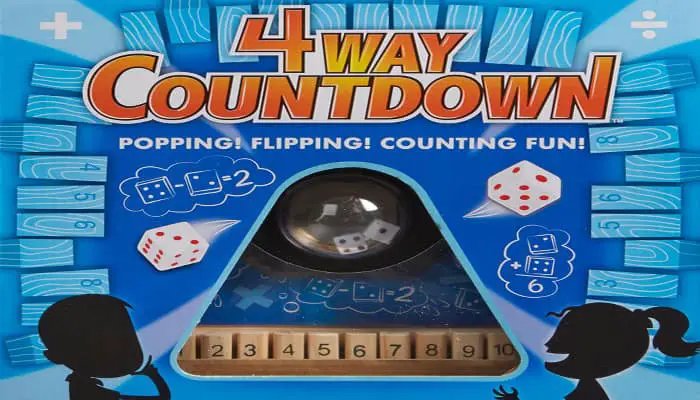

Components
- Wooden Game Board
- Attached Dice Popper
- 40 Attached Flip Keys
- Rulebook
Object of the Game
The first player to flip up all 10 keys on his/her side of the 4-Way CountDown game board wins the game.
Game Play
Players lay down all 10 keys on their sides of the 4-Way CountDown unit.
Players each roll one die to determine who goes first. Player with the highest roll will begin the game. Play then moves to the left.
The first player rolls the dice in the center of the game board (in the middle of the four sets of keys). The two numbers rolled must be converted into one number by using any of the following methods:

Example 1: If a player rolls a 2 and a 4 on the dice, she/he has the following options:
Add: 2 + 4 = 6. Player may flip up the 6 key
Subtract: 4-2 = 6. Player may flip up the 2 key
Multiply: 4x2 = 8. Player may flip up the 8 key
Divide: 4 divided by 2 = 2. Player may flip up the 2 key.
Example 2: If a player rolls a 5 and a 3 there are only two options:
Add: 5 + 3 = 8. Player may flip up the 8 key
Subtract: 5-3 = 2. Player may flip up the 2 key
Roll Double 6: If a player rolls a double six she/he must flip all of his keys back down and start over.
Roll An 11: If a player rolls a 6 and a 5 it may be counted as a 1 (using the subtraction option) OR as an 11. If counted as an 11, the player may take any opponent of their choice flip all of their keys back down and make them start over.

Junior Play Version
Play is the same as the adult version except a player has only two options after roll.
Addition
A player may add up the two numbers on the dice to determine the number key to be flipped. OR
Score Keys
A player may use both numbers on the dice and flip two keys.
Example: If the player rolls a 5 on one die and a 3 on the other, she/he may turn over the 5 key and the 3 key OR she/he may add the 5 + 3 and flip only the 8 key.
Important: Players must use both numbers rolled on a turn except when a double is rolled.
For example, if a 3 and a 5 are rolled and the player has already flipped over the 8 and the 3 key in previous turns, the player cannot flip the 5 key on that turn because both dice must be used.
If two 5's are rolled and the 10 key has already been flipped, the player can still flip over the 5 key.
Rolling double 6 or Rolling an 11 has the same outcome as in the adult version.
Continue Reading


